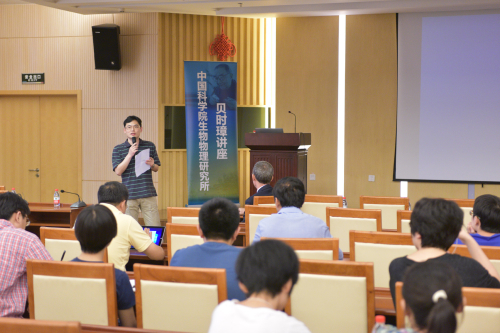Prof. Michael F. Summers from the Howard Hughes Medical Institute Visited IBP and Delivered a Shizhang Bei Lecture
Prof. Michael F. Summers from the Howard Hughes Medical Institute, who visited Institute of Biophysics(IBP), Chinese Academy of Sciences (CAS) on August 27, 2015, delivered a Shizhang Bei Lecture entitled Insights into the Structural Basis and Mechanism of HIV-1 Genome Packaging. Prof. Zheng Zhou hosted the lecture, and Prof. Bin Xia from Peking University, Prof. Ping Zhu, Prof. Wei Feng, Prof. Jiangyun Wang from IBP, and many researchers and graduate students participated in this interesting report.
Prof. Michael F. Summers, a Principle Investigator of the Howard Hughes Medical Institute, is also a Distinguished Professor of chemistry and biochemistry at the University of Maryland. He is dedicated to the research on the maturation and infection mechanism of retroviruses, especially the Human Immunodeficiency Virus (HIV) using nuclear magnetic resonance (NMR). By studying the structure and dynamics of proteins and the interaction between proteins and RNA, he strives to understand how HIV and other retroviruses assemble, and how they package their genetic materials by virtue of which viruses can infect other cells. Their studies aid in the design of new treatment approaches to AIDS and other human diseases caused by retroviruses.
Prof. Michael F. Summers introduced their recent progress on the study of HIV RNA packaging. Currently many protein structures about HIV-1 virus have been reported. However, there are few papers about the nucleic acid structure of HIV-1 virus, partly due to the limitation of traditional NMR technique or X-ray Crystallography. By fr-RNA 2H -edited NMR technique, the research team of Michael F.Summers resolved the structure of HIV-1 RNA, which was published in Science.
The 5rs resolved the structure of HIV-1 RNA, which was published in Sciencetive packaging of the unspliced, dimeric viral RNA into assembling particles. By using the 2H-edited NMR approach, they determined the structure of a 155-nucleotide region of the leader that is independently capable of directing packaging(core encapsidation signal; ΨCES). The RNA adopts an unexpected tandem three-way junction structure, in which residues of the major splice donor and translation initiation sites are sequestered by long-range base paring and guanosines essential for both packaging and high-affinity binding to the cognate Gag protein are exposed in helical junctions. The structure reveals how translation is attenuated. Gag binding promoted, and unspliced dimeric genomes selected, by the RNA conformer that directs packaging.
Prof.Michael F. Summers pointed out that fr-RNA 2H-edited NMR approach can be used to studythe structure of medium length RNA (~160 nt).He also discussed specific scientific problems with regard to the new approach tothe study of protein and RNA and enlightened the researchers. This lecture was inspiring and very impressive for all the audience. After the lecture, Prof. Michael F. Summers and the audience shared their views on the issues of common interest.





